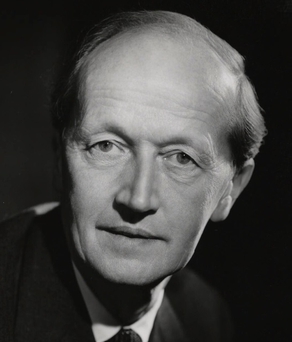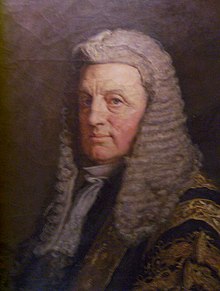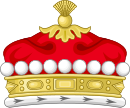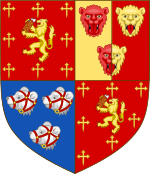
Viscount Hailsham, of Hailsham in the County of Sussex, is a title in the Peerage of the United Kingdom. It was created in 1929 for the lawyer and Conservative politician Douglas Hogg, 1st Baron Hailsham, who twice served as Lord High Chancellor of the Great Britain. He had already been created Baron Hailsham, of Hailsham in the County of Sussex, in 1928, also in the Peerage of the United Kingdom. Hogg was the son of the merchant and philanthropist Quintin Hogg, seventh son of Sir James Hogg, 1st Baronet, whose eldest son James McGarel-Hogg, 2nd Baronet was created Baron Magheramorne in the Peerage of the United Kingdom in 1887.

Marquess of Londonderry, of the County of Londonderry, is a title in the Peerage of Ireland.

Earl Nelson, of Trafalgar and of Merton in the County of Surrey, is a title in the Peerage of the United Kingdom. It was created on 20 November 1805 for the Rev. William Nelson, 2nd Baron Nelson, one month after the death of his younger brother Vice-Admiral Horatio Nelson, 1st Viscount Nelson, the famous naval hero of the Napoleonic Wars and victor of the Battle of Trafalgar of 21 October 1805. The title is extant, the present holder being Simon Nelson, 10th Earl Nelson, who has an heir apparent. The family seat of Trafalgar House in Wiltshire was sold in 1948 by Edward Nelson, 5th Earl Nelson.

Earl of Cottenham, of Cottenham in the County of Cambridge, is a title in the Peerage of the United Kingdom. It was created in 1850 for the prominent lawyer and Whig politician Charles Pepys, 1st Baron Cottenham. ) He served as Lord Chancellor from 1836 to 1841 and from 1846 to 1850. Pepys had already been created Baron Cottenham, of Cottenham in the County of Cambridge, in 1836, and was made Viscount Crowhurst, of Crowhurst in the County of Surrey, at the same time he was given the earldom. These titles are also in the Peerage of the United Kingdom. The viscountcy is used as a courtesy title for the Earl's eldest son and heir apparent.

Earl Cairns is a title in the Peerage of the United Kingdom. It was created in 1878 for the prominent lawyer and Conservative politician Hugh Cairns, 1st Baron Cairns. He was Lord High Chancellor of Great Britain in 1868 and from 1874 to 1880. Cairns had already been created Baron Cairns, of Garmoyle in the County of Antrim, in 1867, and was made Viscount Garmoyle, in the County of Antrim, at the same time he was given the earldom. These titles are also in the Peerage of the United Kingdom.
Viscount Mackintosh of Halifax, of Hethersett in the County of Norfolk, is a title in the Peerage of the United Kingdom. It was created on 10 July 1957 for the businessman and public servant Harold Mackintosh, 1st Baron Mackintosh of Halifax. He was the owner of the confectionery business of John Mackintosh & Sons Ltd and for many years Chairman of the National Savings Committee. Mackintosh had already been created a baronet, of Halifax in the West Riding of the County of York, in the Baronetage of the United Kingdom on 28 January 1935, and Baron Mackintosh of Halifax, of Hethersett in the County of Norfolk, on 6 February 1948, also in the Peerage of the United Kingdom. As of 2023 the titles are held by his grandson, the third Viscount, who succeeded his father in 1980.

Viscount Bledisloe, of Lydney in the County of Gloucestershire, is a title in the Peerage of the United Kingdom. It was created in 1935 for the Conservative politician Charles Bathurst, 1st Baron Bledisloe, upon his retirement as Governor-General of New Zealand. He had already been created Baron Bledisloe, of Lydney in the County of Gloucestershire, in 1918, also in the Peerage of the United Kingdom. Bathurst was the great-grandson and namesake of the early-19th-century politician Charles Bathurst. The latter was the son of Charles Bragge and Anne Bathurst, granddaughter of Sir Benjamin Bathurst, younger brother of Allen Bathurst, 1st Earl Bathurst. In 1804, Charles Bathurst assumed the surname of Bathurst in lieu of Bragge. The first Viscount's grandson, third Viscount, was one of the ninety elected hereditary peers that were allowed to remain in the House of Lords after the passing of the House of Lords Act 1999, and sat as a crossbencher until his death. He was also a member of the Lords Constitution Committee. As of 2017 the titles are held by his son, the fourth Viscount, who succeeded in 2009.

Viscount Chilston, of Boughton Malherbe in the County of Kent, is a title in the Peerage of the United Kingdom. It was created in 1911 for the Conservative politician and former Home Secretary, Aretas Akers-Douglas. The title derives from Chilston Park, Akers-Douglas's country house in Kent. He was made Baron Douglas of Baads, in the County of Midlothian, at the same time, also in the Peerage of the United Kingdom. His son, the second Viscount, served as British Ambassador to Russia from 1933 to 1938. He was succeeded by his eldest surviving son, the third Viscount. As of 2010 the titles are held by the latter's first cousin once removed, the fourth Viscount, who succeeded in 1982. He is the grandson of the Hon. George Alexander Akers-Douglas, second son of the first Viscount.
Viscount Camrose, of Hackwood Park in the County of Hampshire, is a title in the Peerage of the United Kingdom. It was created on 20 January 1941 for the prominent newspaper magnate William Berry, 1st Baron Camrose. He had previously received the award of Baronet, of Long Cross in the County of Surrey, in the Baronetage of the United Kingdom, on 4 July 1921, and was created Baron Camrose, of Long Cross in the County of Surrey, on 19 June 1929, in the Peerage of the United Kingdom. His second son, the third Viscount, disclaimed the peerages in 1995 on succeeding his elder brother. However, he had already been created a life peer as Baron Hartwell, of Peterborough Court in the City of London, on 19 January 1968. On his death in 2001 the life peerage became extinct while he was succeeded in the other titles by his eldest son, the fourth Viscount. The first three Viscounts all headed The Daily Telegraph at one point, the first having purchased it from Harry Levy-Lawson, 1st Viscount Burnham, but in the 1980s they lost control to Conrad Black.

Viscount Devonport, of Wittington in the County of Buckingham, is a title in the Peerage of the United Kingdom. It was created on 22 June 1917 for the Liberal politician and former Member of Parliament for Devonport, Hudson Kearley, 1st Baron Devonport. He had already been created a Baronet, of Wittington in the Parish of Medmenham in the County of Buckingham on 22 July 1908, and Baron Devonport, of Wittington in the County of Buckingham, on 15 July 1910. As of 2017 the titles are held by his grandson, the third Viscount, who succeeded his father in 1973.

Baron Ellenborough, of Ellenborough in the County of Cumberland, is a title in the Peerage of the United Kingdom. It was created on 19 April 1802 for the lawyer, judge and politician Sir Edward Law, Lord Chief Justice of the King's Bench from 1802 to 1818. His son, the second Baron, notably served as Governor-General of India. On 22 October 1844 the second Baron was created Viscount Southam, of Southam in the County of Gloucester, and Earl of Ellenborough, in the County of Cumberland. These titles were also in the Peerage of the United Kingdom. His only son predeceased him and on his death in 1871 the viscountcy and earldom became extinct.

Baron Harmsworth, of Egham in the County of Surrey, is a title in the Peerage of the United Kingdom. It was created in 1939 for the Liberal politician Cecil Harmsworth, Under-Secretary of State for Foreign Affairs between 1919 and 1922. As of 2017 the title is held by his grandson, the third Baron, who succeeded his uncle in 1990.
Baron Selsdon, of Croydon in the County of Surrey, is a title in the Peerage of the United Kingdom. It was created on 14 January 1932 for the Conservative politician Sir William Mitchell-Thomson, 2nd Baronet. His son, the second Baron, was a successful racing driver, winning the 1949 24 Hours of Le Mans in the first Ferrari. As of 2009 the titles are held by the second Baron's only son, the third Baron, who succeeded in 1963. He is one of the ninety elected hereditary peers that remain in the House of Lords after the House of Lords Act of 1999. Lord Selsdon sits on the Conservative benches. The Mitchell-Thomson Baronetcy, of Polmood in the County of Peebles, was created in the Baronetage of the United Kingdom on 26 September 1900 for the first Baron's father, Sir Mitchell Mitchell-Thomson, Lord Provost of Edinburgh from 1897 to 1900.
Baron Killearn, of Killearn in the County of Stirling, is a title in the Peerage of the United Kingdom. It was created in 1943 for the diplomat Sir Miles Lampson. He was the second son of Norman Lampson, youngest son of Sir Curtis Lampson, 1st Baronet, of Rowfant. Lord Killearn's eldest son, the second Baron, succeeded his second cousin once removed as fourth Baronet in 1971. On his death the titles passed to his half-brother, the third and present holder of the barony and baronetcy.
Baron Nathan, of Churt in the County of Surrey, is a title in the Peerage of the United Kingdom. It was created on 28 June 1940 for the lawyer and politician Harry Nathan. As of 2010 the title is held by his grandson, the third Baron, who succeeded his father in 2007.

Baron Newall, of Clifton-upon-Dunsmoor in the County of Warwick, is a title in the Peerage of the United Kingdom. It was created on 18 July 1946 for Marshal of the Royal Air Force Sir Cyril Newall. He was Chief of the Air Staff between 1937 and 1940 and Governor-General of New Zealand between 1941 and 1946. As of 2017 the title is held by his only son, the second Baron, who succeeded in 1963.

Baron Silsoe, of Silsoe in the County of Bedford, is a title in the Peerage of the United Kingdom. It was created on 18 January 1963 for the barrister Sir Malcolm Trustram Eve, 1st Baronet. He had already been created a Baronet, of Silsoe in the County of Bedford, on 18 January 1943. He was succeeded by his son, the second Baron. Known as David Silsoe, he was also a barrister. As of 2017 the titles are held by his son Simon, the third Baron, who succeeded in 2005.
Baron Cunliffe, of Headley in the County of Surrey, is a title in the Peerage of the United Kingdom. It was created in 1914 for Walter Cunliffe, Governor of the Bank of England from 1913 to 1918. As of 2010 the title is held by his grandson, the third Baron, who succeeded his father in 1963.

William Baliol Brett, 1st Viscount Esher, PC, known as Sir William Brett between 1868 and 1883, was a British lawyer, judge, and Conservative politician. He was briefly Solicitor-General under Benjamin Disraeli and then served as a justice of the Court of Common Pleas between 1868 and 1876, as a Lord Justice of Appeal between 1876 and 1883 and as Master of the Rolls. He was raised to the peerage as Baron Esher in 1885 and further honoured when he was made Viscount Esher on his retirement in 1897.

Lionel Gordon Baliol Brett, 4th Viscount Esher, 4th Baron Esher CBE was a British peer, architect and town-planner. He succeeded to his title on the death of his father in 1963.














